There are a lot of Australian native flowers with a show-stopping appeal, but none are quite as miraculous as the Waratah. The floral emblem of New South Wales, the brilliant, bright red Waratah is a spectacular choice for Australian gardens – that need only a little yearly attention to promote a bountiful bloom.
Here is everything you need to know to cultivate, care for and grow the Waratah Telopea.
More...
What is a Waratah?

The Waratah is a genus that includes 5 species of smaller shrubs and medium-sized trees. Part of the Proteaceae family, these long-living plants stem from the Southeastern parts of Australia including NSW, Victoria and Tasmania.
The Telopea speciosissima (NSW Waratah or New South Wales Waratah) is a particularly showy cultivar with large red blooms and green, oblong leaves. Waratah flowers profusely over 6 weeks, usually between September and October.
This is one of the most popular varieties found in Australian gardens. However, there are a range of other Waratahs you can consider growing. While it’s most often used as a cut flower, these plants make for a fantastic garden plant, whether in a pot or in soil.
Waratah Varieties
Here are some of our favourite varieties to grow:
Telopea ‘Shady Lady Red’This is a showy variety, perfect for colder regions in Australia. This is a cross between the T. speciosissima and T. oreades and it is known to be a big garden performer. This variety is best suited to acidic soils and will need quite a bit of support with a native fertiliser. | 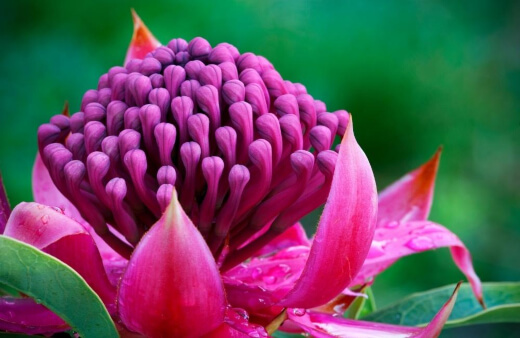 |
Telopea ‘Golden Globe’An intricate variety with cream and white flower cones and grey-green foliage. This variety is great for garden beds and rockeries. |  Source: gardeningwithangus.com.au |
Tasmanian Waratah (Telopea truncata)Also referred to as the Tasmanian Waratah, is an upright growing shrub which can reach as much as 3 metres tall. The flowers bloom into large clusters and are easily grown from seed. |  |
Gibraltar Range Waratah (Telopea aspera)Referred to as the Gibraltar Range Waratah, this variety is another crimson bloomer with particularly large flowers. It offers attractive dark green foliage and blooms which strongly resemble those of the T. speciosissima. |  Source: inaturalist.ca |
Braidwood Waratah (Telopea mongaensis)Also called the Braidwood waratah or Monga waratah, this variety is best suited to the cooler regions of Australia. It grows best in semi-shaded positions with moisture-rich soils. | 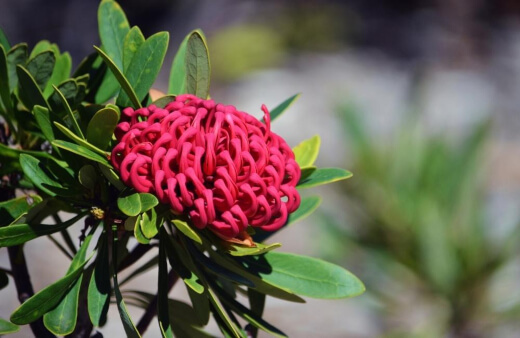 |
Victorian Waratah (Telopea oreades)Found natively in wetter forests, the gippsland waratah has tube-like flower petals and can reach as much as 3 metres tall. It grows happily in acidic soils and won’t have a hassle in moisture-laden soils. |  Source: farreachesfarm.com |
Telopea ‘Shady Lady Red’

This is a showy variety, perfect for colder regions in Australia. This is a cross between the T. speciosissima and T. oreades and it is known to be a big garden performer.
This variety is best suited to acidic soils and will need quite a bit of support with a native fertiliser.
Telopea ‘Golden Globe’

Source: gardeningwithangus.com.au
An intricate variety with cream and white flower cones and grey-green foliage. This variety is great for garden beds and rockeries.
Tasmanian Waratah (Telopea truncata)

Also referred to as the Tasmanian Waratah, is an upright growing shrub which can reach as much as 3 metres tall. The flowers bloom into large clusters and are easily grown from seed.
Gibraltar Range Waratah (Telopea aspera)

Source: inaturalist.ca
Referred to as the Gibraltar Range Waratah, this variety is another crimson bloomer with particularly large flowers. It offers attractive dark green foliage and blooms which strongly resemble those of the T. speciosissima.
Braidwood Waratah (Telopea mongaensis)

Also called the Braidwood waratah or Monga waratah, this variety is best suited to the cooler regions of Australia. It grows best in semi-shaded positions with moisture-rich soils.


Get Your Free Guide:
Master Growing Australian Natives eBook
A Must Have Complete Guide for Every Australian Garden
Get Your Free Guide:
Master Growing Australian Natives eBook
A Must Have Complete Guide for Every Australian Garden
Victorian Waratah (Telopea oreades)

Source: farreachesfarm.com
Found natively in wetter forests, the gippsland waratah has tube-like flower petals and can reach as much as 3 metres tall. It grows happily in acidic soils and won’t have a hassle in moisture-laden soils.
How to Grow Waratahs in Australia
Before you get ready to plant, it’s important to pick the right spot. These plants are considered to be overly picky. However, they need the right level of moisture and sunlight to bloom properly.
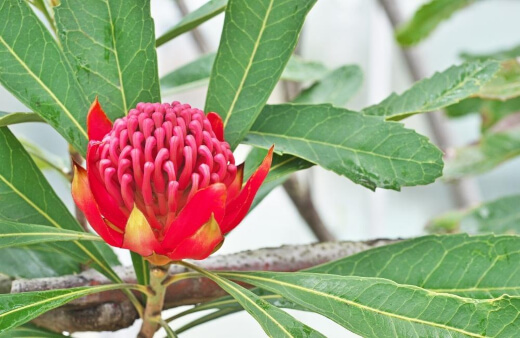
Pick a spot that gets some partial shade. Ideally, you don’t want to keep your plant anywhere where it’ll sit in full sun or full shade, either can be damaging for your plants.
Most importantly, your plant will need some protection from the hot afternoon sun. A free-draining soil medium is ideal. This plant enjoy a good level of moisture but can’t stand having wet feet.
If growing this Australian native in your garden, aim for slightly acidic, sandy soils for the best results. For clay soils, it may be necessary to prepare the soil before planting.
Adding some gypsum can help to improve the soil. If growing in a pot, it’s advisable to pick a native potting mix that allows any excess water to drain freely.
Planting Waratah Flowers
Telopea is ideal for growth in both pots and soils. Still, for both some pre-preparation may be necessary.
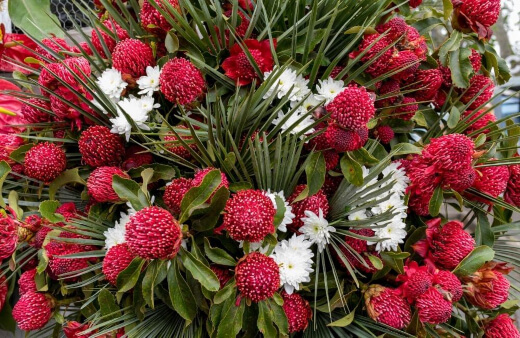
Growing Waratah in Soil
- Before planting it’s a good idea to prepare the planting site and give it an additional nutritional nudge by mixing a slow-release, granular fertiliser into the soil.
- Dig a hole twice the size of the root ball and the same depth as the pot in which it was planted.
- Remove the plant from its original pot, taking care not to disturb the roots too much.
- Place the root ball in the hole, centring it, and backfill with the rest of the soil.
- Create a small ring of soil around the base of the stem. This will help to retain moisture and deter weeds.
- Mulch the soil along the outer ring after planting.
- Water well in the first week after planting.
Planting Waratah in Pots
- Pick a pot that is twice the size of the root ball. This will give roots plenty of space to grow into.
- Pick a quality, native potting mix and fill the pot up 1/3 with it.
- Gently remove the root ball from the original plant, taking care not to damage the roots.
- Place into the pot, on top of the soil and backfill with the remaining soil until it is level with the edge of the pot.
- Create a ring of soil around the stem.
- Mulch well, taking care not to get too close to the stem.
- Water well in the first week after planting.
How to Propagate Waratah

This plant can be propagated from cuttings or from seeds. However, seed often seems the easier option of the two.
Still, it is important to note that waratahs that are propagated from seed take around 5 years to begin flowering. Waratahs propagated from cuttings only need 2 years.
Waratah Propagation from Seed
- Fresh seeds offer the best results. These should be no older than 6 months old.
- Prepare a small pot with a rich, seeding mix.
- Sow the seed a few centimetres down, covering it lightly with soil.
- Keep in a warm, semi-shaded spot and keep the soil moist. Never let it dry out.
- Seeds take around 2 to 3 weeks to germinate.
Propagating Waratah from Cutting
- Prepare a small pot, with rich, free-draining soil.
- Use a sharp sterilized blade to remove a stem cutting from healthy, thriving plants.
- Remove a cutting around 5 to 6 centimetres in length. Ensure it has a few healthy nodes along the stem.
- Remove any lower leaves, dip into a rooting hormone and plant into the soil.
- Keep your pot in a warm, sun-dappled spot.
- Regularly mist the soil to keep it moist. Avoid overwatering seeds as this can lead to fungal disease.
Cuttings are best taken during the spring or early summer when plants are in an active growing phase.
Young plants can be transplanted as soon as they are ready to handle. This is usually when they reach around 15 centimetres in height. Keep young plants well-watered after planting.
Waratah Care Guide
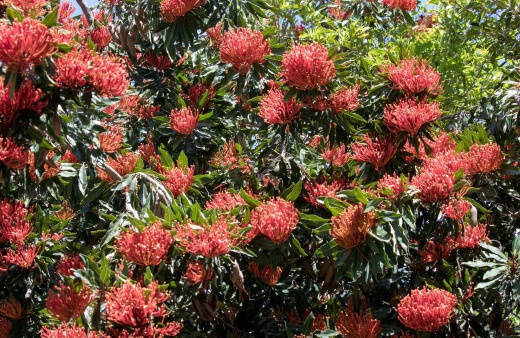
This plant has a pretty straightforward care routine mostly focused around watering and pruning to ensure it blooms profusely year after year.
They will need regular watering, without overly soaking the soil. Do not let the roots dry out, but avoid leaving the soil too wet. You can regularly check the soil with fingers or use a soil moisture meter for the best results.
These plants respond incredibly well to pruning and should be cut back once they are down flowering. Remove flowers, perhaps for a flower bouquet and then cut stems back to half of their length.
Ensure you use a clean, sterilised pair of garden shears to avoid the spread of any diseases to your plants. (Get the best garden shears available online.)
After pruning, a slow-release, low-phosphorus fertiliser. This will encourage vigorous growth in the next flowering season. Young plants can be fertilised more often than established plants.
This can be done as often as every 2 to 3 weeks to strengthen roots and boost growth. It is always a good idea to consider a low-nitrogen, organic native fertiliser as opposed to artificial fertilisers.
Telopea Pest & Disease Problems
Although these plants are considered to be rather hardy, they can fall victim to common plant issues. These include:
- Browning & Yellowing Foliage. Discoloured foliage is usually a sign that there is a deficiency or larger issue. Yellowing foliage is commonly due to scale damage or an incorrect pH level in the soil.
Aim to keep your soil at a pH level between 5 to 6. Browning leaves can occur when your plants are exposed to too much direct sunlight or heat. This will cause leaves to scorch. Consider protecting your plant from the afternoon sun or moving to a more shaded location. - Root Rot. Root rot occurs when plants are overwatered and the soil isn’t draining sufficiently. Wet feet will cause the development of a fungal disease and can lead to rapid plant death. Be sure to improve soil drainage and cut back on your watering routine.
- Caterpillars. Some native caterpillars enjoy feeding on the foliage, buds and stems of your Telopea plant. These can be controlled by picking them off by hand and treating leaves with neem oil or natural insecticide.
Final Waratah Growth Tips
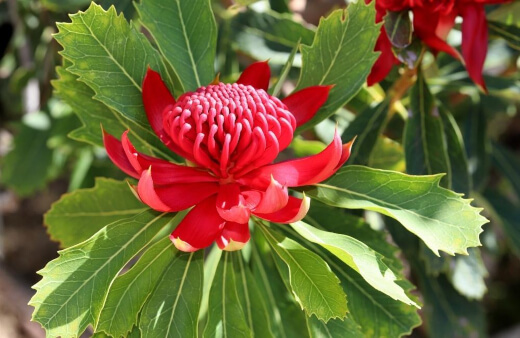
- Depending on where you’re planning to grow your plant, pick a sub-cultivar suited to the environment. Most varieties thrive in warmer climates, but varieties like the ‘Shady Lady’ are suited to cooler climates.
- Exposing your plants to extreme winds during flowering can cause bract burns. Try to keep your plants in a sheltered position to avoid any issues.
- If you’re worried about your plant producing enough flowers, be sure to keep up with a regular pruning routine. Giving plants a good chop will encourage plants to thrive in the following season.
- If you’re worried about the sun, consider growing Waratahs under a shade cloth during the high of summer. This will help to mimic the dappled sunlight of the it's natural growing conditions.
If you’re considering some other gorgeous Australian native flowers to add to your garden? Take a look at our Australian flower guides here.

Embrace the Splendor of Australian Flora with Waratahs
Deciding to grow Telopea is never a bad choice. These spectacular plants provide a gorgeous summer bloom that will leave you wanting more year after year. Be sure the right spot for your Waratah, with the right level of light and well-draining soil for the best results.
Published on February 10, 2022 by Lorri Hopkins
Last Updated on April 7, 2025




